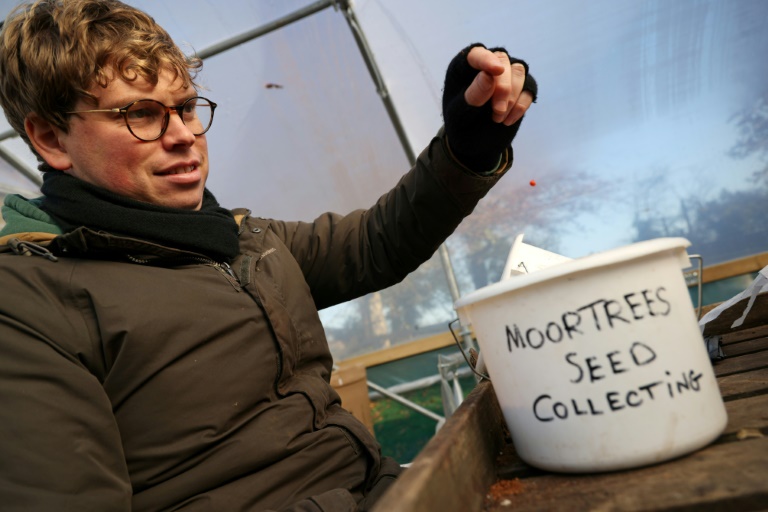Hunched over and heads down in concentration, three workers at Moor Trees, a nursery in southwestern England, shell red seed pods and toss them one by one into a bucket.
The seeds are placed in pots and covered in soil, and those which germinate over the next two years will then be planted in the ground and hopefully grow into full-grown trees.
With the ominous threat of the climate emergency, tree planting has become a fashionable choice for governments and companies looking to capture polluting carbon dioxide emissions or reduce carbon footprints.
The crisis hit the headlines last month when major powers agreed at the COP26 climate summit in Scotland to end deforestation and curb the use of high-polluting fossil fuels.
– ‘Massive public interest’ –
“There’s a massive public interest in tree planting,” Moor Trees director Adam Owen told AFP, speaking alongside rows of sapling trees that are covered in green mesh to protect them from squirrels and other pests.
The charity, based in the city of Totnes in Devon, works alongside landowners to create new hedgerows and woodlands following years of historical UK under-investment.
And demand is booming so much that Owen has not had to seek a single new client since 2018.
“We expanded quite significantly — a few years ago we were doing about 6,000 trees (per year) and now we’re doing 15,000 trees.
“Our aspiration is 25,000 in a few years’ time.
“In three years, I have not had to ask a single person whether we could plant for them.”
Demand is thriving from companies, governments and individuals across the globe.
Eden Project, a US reforestation charity operating in nine countries, saw its budget surge from $5 million in 2019 to $26 million this year, while it targets $120 million by 2023.
Back in Britain, just 13 percent of UK territory is covered in forest or woodland. That compares poorly with the EU average of 39 percent, according to Eurostat data.
– 30 million trees per year –
British Prime Minister Boris Johnson’s government wants to plant 30 million new trees per year from 2025 under UK plans to become carbon-neutral by 2050.
However, recent official data showed there is some way to go after just 4.2 million trees were planted in 2020/2021.
At the same time, land is in short supply because much of it is already built upon — or includes protected habitats like peat marshes.
Seeds are also scarce and often have to be imported, particularly from the Netherlands, but this runs the risk of importing dangerous bacteria.
Moor Trees in contrast uses local tree varieties that are used to the soil conditions.
Growing trees is a complex process that is very time consuming and cannot be regarded a quick fix for the climate crisis, experts say.
– Plea to slash emissions –
New trees cannot be a substitute for badly-needed global reductions in dangerous polluting emissions that worsen climate change.
“The most important thing we have to do is slash our emissions,” said Luke Barley, woodlands specialist at Britain’s National Trust that manages historic properties and countryside.
“But there’s still too much carbon in the atmosphere — that’s where trees can play a significant role” in absorbing carbon.
Businesses, individuals and governments alike still need to alter their approach and refrain from so-called greenwashing, he argued.
“It’s not appropriate for any organisation to continue business as usual and offset their emissions through tree planting,” he concluded.
Large commercial companies must invest to complement the efforts of small-scale players like Moor Trees.
Yet trees alone cannot resolve the ongoing climate crisis.
“Tree planting is not the solution — it’s just one of the solutions,” noted Owen.









